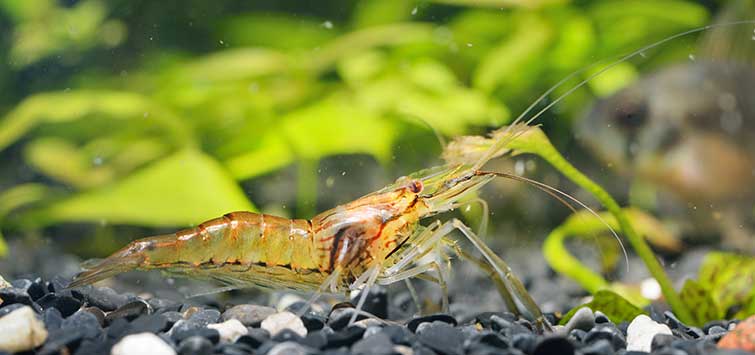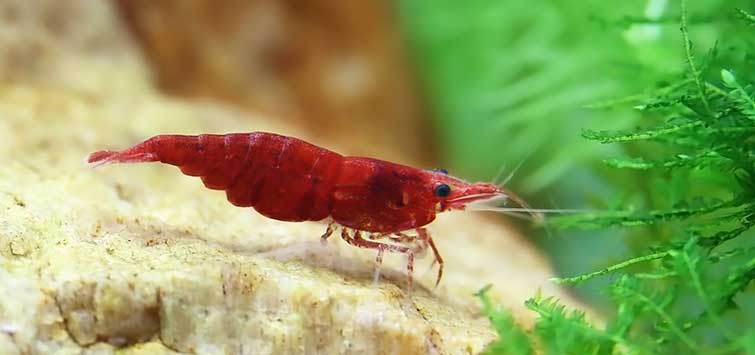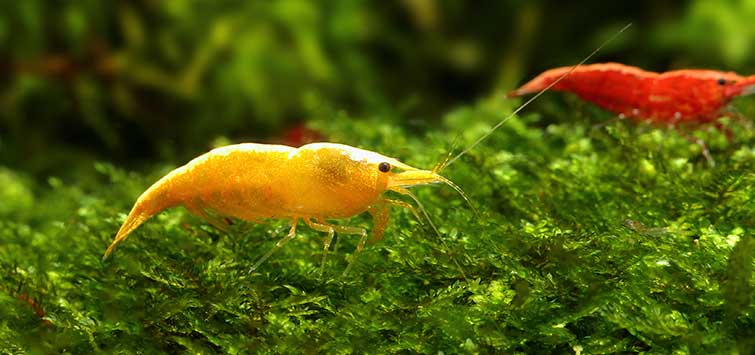Freshwater Prawns
Author: Amanda Wenger
Unlike the small species of shrimp available in the hobby, freshwater prawns grow much larger, are more aggressive, and can become the subject of an interesting dedicated setup.
At a local auction, I encountered a bag of a half dozen or so juvenile shrimp. The label indicated they were Macrobrachium hendersoni, a species of palaemonid shrimp variously referred to as the red-claw shrimp, long-arm shrimp, macro, or freshwater prawn. Seeking to expand my invert collection, and determined to buy something at the event (it was very much a seller’s market that day), I held my bidder card in the air until the bag was mine.
Natural History
Technically speaking, Macrobrachium species aren’t prawns. True prawns belong to the suborder Dendrobranchiata, whereas Macrobrachium spp. are a part of the suborder Pleocyemata, which contains various lower taxa of shrimp, lobsters, crabs, crayfish, and other miscellaneous crustaceans. However, the term “prawn” being a common name, and “freshwater prawn” being a frequently used moniker for members of the genus Macrobrachium, I’ll continue to refer to them as such.
Big Arms
The name Macrobrachium means “big arm,” and most of the genus lives up to that description, bearing a pair of claws (called chelipeds) that range in proportion from lanky to grotesquely exaggerated. The males of most species have even larger, more robust claws, making them easy to sex once they mature. The males are also fiercely territorial, and a larger setup is necessary to keep multiple individuals. They are not, however, typically aggressive toward females.
Native Habitat
Some 200 species of Macrobrachium can be found across nearly every continent except Europe and Antarctica. Most are freshwater or brackish species, with a handful able to tolerate fully marine conditions in the adult phase. The majority of species available to the hobby originate from Indo-Pacific countries, with the occasional representative from the Americas. Macrobrachium species are not commonly imported into the United States, and when they are, typically only a handful of species are available.
On the Market
Macrobrachium species often come inadvertently in shipments of feeder shrimp (variously known as ghost shrimp or glass shrimp). The bulk of these shrimp come from the genus Palaemonetes, another member of the family Palaemonidae, to which Macrobrachium belongs. Juvenile macro specimens are similar in appearance to ghost shrimp and, as such, find their way into pet stores that order bulk shipments of the latter. On closer examination, one can pick out the Macrobrachium specimens by their larger rostrums (what the layperson might call a “nose,” though it has nothing to do with olfactory perception) and/or their longer claws.
Classification
The classification of freshwater prawn species is convoluted at best, due in part to the overlap in their morphology. Defining features are traditionally the rostrum and pereopods (swimming legs), but sexual dimorphism, the varying maturity of collected specimens, and regional variations have all led to some confusion. To add to the trouble, the last major revision of the genus (by Holthuis in the early 1950s) included only about half of the species currently believed to exist. As such, pinning down the exact identity of any one strain of shrimp available to the hobby is difficult.
In Aquaria or Otherwise
As an interesting point, the primary trade in freshwater prawns is not for the aquarium hobby. Larger species are popular in aquaculture and prized as a food source in many countries. Most notable for this purpose is the giant river prawn, M. rosenbergii, a native of Australia and Southeast Asia. While adult M. rosenbergii are very interesting creatures, with bright blue claws and active dispositions, they are not an animal for the casual aquarist. Giant river prawns max out at nearly the size of a small lobster, with arms up to twice the length of their body.
Much better suited to the aquarium are macros from the M. hendersoni complex, a poorly defined group of small-to-medium Indo-Pacific species that notably also includes M. assamense, and M. dayanum, all of which can be found from time to time in imports or from other hobbyists. Unlike many macros, whose larvae (zoeae) require varying degrees of salinity to reach their postlarval stages, these species can be bred purely in freshwater. Apart from the enjoyment of breeding on the part of the hobbyist, this also means these species can be sustained in captivity without too much extra effort.
The long-arm shrimp of the Americas, in comparison, are poorly represented in the hobby. The aforementioned inclusions in feeder shipments tend to be mid-sized species from the southern parts of the US, such as the Ohio River shrimp (M. ohione) and M. americanum. The only South American species that appears with any degree of regularity is M. amazonicum.
Care and Maintenance
In terms of water parameters, freshwater prawns aren’t terribly picky. A pH in the neutral to alkaline range (7.0 to 8.0) is fine. They do not require a heater at room temperature. Like all crustaceans, their water should have at least a bit of calcium in it to keep their carapaces in top condition. In my tanks, this is accomplished with the addition of a bit of crushed coral or some oyster shells. Like most inverts, macros are sensitive to ammonia, so make sure their setup is well established and free of nitrogenous waste. Fortunately, the shrimp themselves have a low impact on the bioload.
Tank Requirements
Tank size is mostly dependent on the individual species. A pair or trio of most red-claw macros (the aforementioned M. hendersoni complex) can be sustained in a 10- to 20-gallon tank. Keeping multiple males requires more space so they can establish territories. Providing the shrimp with refuge in the form of rocks, driftwood, clay pots, and/or sections of PVC tubing is a must—most of my Macrobrachium specimens prefer to choose a house in the form of a cave or nook and spend the majority of their time poking around the immediate vicinity (close enough to duck for cover should they perceive a threat), looking for food, or warding off intruders by flailing their largest limbs. Come to think of it, this behavior isn’t terribly different from any number of fish I’ve kept.
Feeding
Unlike the many algae-eating and filter-feeding shrimp that can be found in the hobby these days, Macrobrachium are omnivores. As such, they need some proportion of meaty foods in their diet and appreciate a varied menu. I offer mine a mix of algae wafers and earthworm sticks with frozen foods (such as bloodworms and brine shrimp) as an occasional treat. They devour all of the above and often squabble over choice bits of food, each dragging a morsel back to its favorite hiding place to nibble at. Such disputes rarely result in injury.
Suitable Tankmates
Finding a Sweet Spot
Mid- to large-size macros will also engage in predatory behaviors. As such, choosing tankmates can be a tricky prospect and, for the most part, a species tank is the safest bet (especially if the goal is breeding the prawns, as their tiny larvae make good snacks for almost anything). Any companions would have to be large enough to avoid predation from the macros but not large enough to eat the shrimp themselves. Though I’ve never tried it myself, I would imagine a well-armored, herbivorous fish, such as a larger plecostomus, might be the best bet.
Keeping fish of an equal size to the prawn(s) is generally not advisable unless you’re working with a very small species. As a case in point, I inherited my Amazon River prawn (M. amazonicum), a lovely specimen with a body some 4 inches long (twice that if you count the claws), when its previous owner got tired of it catching and eating adult Siamese algae eaters and other fish of a similar size. Even the fastest of fish will slow down when they sleep at night—at which point, the prawn may decide they look tastier than the food it’s been deliberately offered.
Prolific Fish
The other alternative is, of course, to use fish that are not particularly dear to you and are exceedingly prolific. My pair of M. dayanum is housed in a 10-gallon tank along with a swarm of assorted guppies. Given their rate of reproduction, I never can quite keep tabs on whether any individual guppy is present from one day to the next, but suffice it to say that their population appears stable. Should the occasional fish vanish into the gullet of a shrimp, I’m not terribly heartbroken.
Working with Small Prawns
In the case of particularly small prawns, such as the Indian whisker shrimp (M. lamarrei or similar), any tankmate suitable for small inverts will be fine, including other small inverts.
The bag of prawns I obtained in the auction mentioned previously turned out to be of this variety, rather than the indicated M. hendersoni, and currently live in a tank with a colony of red cherry shrimp (Neocaridina heteropoda “red”) and Malaysian trumpet snails (Melanoides tuberculatus). The choice of the trumpet snails was deliberate, as they have particularly sturdy opercula that can effectively shut out curious claws. More delicate pest snails, such as ramshorn and pond snails, lack such opercula and are gladly picked out of their shells and eaten by my macros. The cherry shrimp in this tank do not breed quite as readily as they do in setups with less-predatory companions, but enough plant cover is present that some still manage to reach adulthood.
Though they are known to dig up small, delicate plants, such as dwarf hairgrass (Eleocharis sp.) in the course of foraging, most red-claw prawns are not terribly destructive to vegetation and are suitable for planted tanks. As is the case with almost all inverts, high-tech, CO2-injected plant setups are not appropriate homes—the carbonic acid created by dissolved CO2 will erode their calcium-rich carapaces, and shrimp, as a rule, prefer well-oxygenated water. More appropriate plant species are those that are low-maintenance and tolerant of slightly hard water; good candidates include Cryptocoryne spp., Java fern, mosses, Anubias spp., and hornwort(Ceratophyllum demersum), among others.
Captive Breeding
As previously mentioned, not all Macrobrachium species can be easily bred in captivity. Most species are amphidromous (having phases of life that occur in both fresh and saline water). Adult prawns of this type live in freshwater coastal rivers and streams. When they spawn, the eggs wash downstream into brackish or marine water. The zoeae need saline conditions to metamorphose into their secondary (adult-shaped) forms, after which they crawl back upstream, mature, and repeat the cycle. Replicating these conditions in captivity requires a dedicated, scientific approach that, among other issues, amounts to a lot of work with limited yield.
Much easier to breed are prawns that live further inland or in landlocked waters. These animals’ natural habitat doesn’t accommodate an amphidromous life cycle, and, as such, their larvae can grow to adulthood in pure fresh water.
Eggs
The M. lamarrei I purchased at the auction did just that. Within a few months of their introduction to my tank, they tripled in size and two of the females were berried (carrying fertile eggs). The eggs of this species are greenish and roughly 1 mm in diameter. My females appeared to be carrying roughly the same sized clutch as a typical red cherry shrimp would (with eggs numbering in the tens as opposed to the hundreds or thousands of eggs amphidromous species often carry).
Offspring
Roughly a month later, they appeared to drop their eggs, but a couple weeks after that, I noticed for the first time a handful of tiny little prawns that had made it to their adult phase (albeit still in miniature). With their transparent bodies and miniscule size, I unfortunately missed out on seeing them in their larval form. In any case it was satisfying to have offspring survive my first attempt at breeding the species. There was some slight attrition as they grew (a notably slower process than the raising of dwarf freshwater shrimp) but in the end, a couple made it to adult size.
I suspect that in a larger environment, the yield from the hatching would be greater as the juveniles would have less opportunity to predate on each other. As such, I intend to introduce the whisker shrimp to either a larger tank or an outside tub this summer to see how a change in environment impacts their reproduction.
The Future of Macros
Hopefully, the increasing popularity of freshwater inverts will encourage the captive breeding and importation of more species from this complex genus of crustaceans. In Asia and Australia, there are a number of interestingly patterned species, varying widely from the species available to US hobbyists. I’m certain several of these would be of great interest to American hobbyists should they become available. M. gracilirostre particularly comes to mind as a good example, as it has a lovely pattern of thin red lines, vaguely reminiscent of the popular marine peppermint shrimp (Lysmata wurdemanni).
Whether we see a rise in international trade or not, the macro species available to the hobbyist right now are still quite fascinating and well worth a dedicated tank should you be looking for something a little different in your inverts.

.png?h=595&iar=0&w=2781&hash=5FD5E69473BCC22199FBFA2FB71B6033)

.png?h=250&iar=0&w=300&hash=DBC8F7A5762D4B011941383087ED8417)

